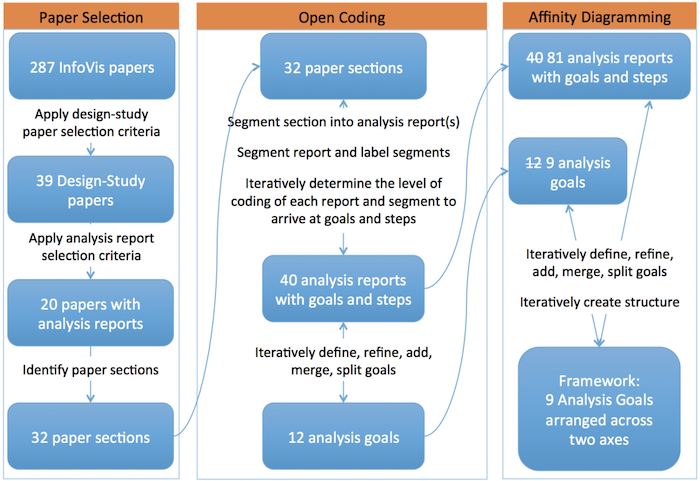Bridging From Goals to Tasks with Design Study Analysis Reports
Abstract |
Paper |
Talk |
Videos |
Figures |
Supplemental Material
Abstract
Visualization researchers and practitioners engaged in generating or evaluating designs are faced with the difficult problem
of transforming the questions asked and actions taken by target users from domain-specific language and context into more abstract
forms. Existing abstract task classifications aim to provide support for this endeavour by providing a carefully delineated suite of actions.
Our experience is that this bottom-up approach is part of the challenge: low-level actions are difficult to interpret without a higher-level
context of analysis goals and the analysis process. To bridge this gap, we propose a framework based on analysis reports derived from
open-coding 20 design study papers published at IEEE InfoVis 2009-2015, to build on the previous work of abstractions that collectively
encompass a broad variety of domains. The framework is organized in two axes illustrated by nine analysis goals. It helps situate the
analysis goals by placing each goal under axes of specificity (Explore, Describe, Explain, Confirm) and number of data populations
(Single, Multiple). The single-population types are Discover Observation, Describe Observation, Identify Main Cause, and Collect
Evidence. The multiple-population types are Compare Entities, Explain Differences, and Evaluate Hypothesis. Each analysis goal is
scoped by an input and an output and is characterized by analysis steps reported in the design study papers. We provide examples
of how we and others have used the framework in a top-down approach to abstracting domain problems: visualization designers or
researchers first identify the analysis goals of each unit of analysis in an analysis stream, and then encode the individual steps using
existing task classifications with the context of the goal, the level of specificity, and the number of populations involved in the analysis.
Paper
Bridging From Goals to Tasks with Design Study Analysis Reports
Talk
Heidi Lam
presented this paper in the
Design session at
11:30 am on Wed Oct 4 2017 at
IEEE InfoVis 2017.
Video
High-Resolution Figure
Supplementary Materials
Last modified: Thu Dec 31 2020

